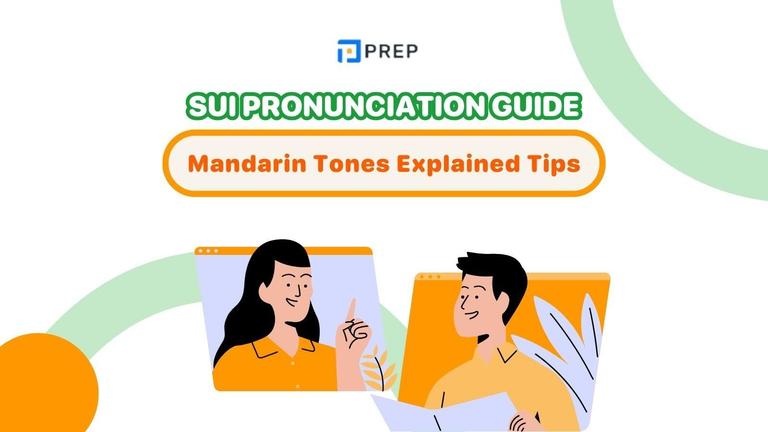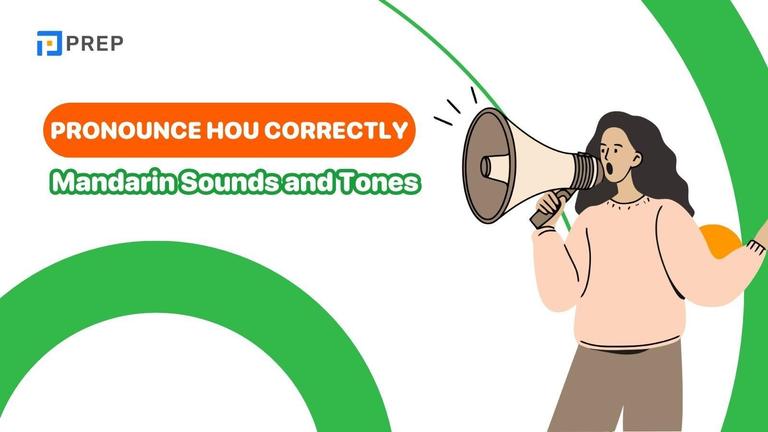4 steps to conquer the Plan/Map Labelling task in IELTS Listening
In the IELTS Listening Map Labelling task, lots of candidates lose marks when they can't figure out which part of the audio matches the map. And if they miss one question and can't find their place again, they might end up getting all five questions wrong. Therefore, to help Preppies achieve high scores, in this article, PREP would like to share the 4 detailed steps to conquer the Plan/Map Labelling task in IELTS Listening. Let's take a look!
- I. What is the Plan/Map Labelling task in IELTS Listening?
- II. Format of the Plan/Map Labelling task in IELTS Listening
- III. Types of Maps in the Plan/Map Labelling task in IELTS Listening
- IV. Common Mistakes in Plan/Map Labelling task in IELTS Listening
- V. Steps for Completing the Plan/Map Labelling task in IELTS Listening
- VI. Some tips to conquer the Plan/Map Labelling task in IELTS Listening
- VII. Practice Plan/Map Labelling task in IELTS Listening with detailed answers
- VIII. From Beginner to IELTS Mastery

I. What is the Plan/Map Labelling task in IELTS Listening?
Plan/Map Labelling task in IELTS Listening is a type of task that requires filling in the blanks with appropriate answers corresponding to the locations on the given map. This type of task often appears in part 2 of the Listening test.
The instructions for the Plan/Map Labelling task in IELTS Listening will be presented under maps or floor plans along with corresponding answers for the locations on that map. The content of the test will be related to daily life, involving information about a specific location or event. The candidate's task is to choose the correct answers and fill them in on the answer sheet.

II. Format of the Plan/Map Labelling task in IELTS Listening
The Plan/Map Labelling task in IELTS Listening may appear in two formats: maps or diagrams. Specifically:
|
A map |
Locations on a map are usually open spaces, and the audio will use the word "map" to describe it. In the test, if a compass appears, candidates will be prompted to use the compass on the right or left corner of the map to complete the task. A map in the test is typically small-scale and mainly used for a large area (such as a town, park, etc.). In some Map Labelling tasks, the audio may present proposed changes to an area. For example: |
|
A plan |
When the location in the task is a building, the word "plan" is often used instead of "map". Therefore, a compass will not appear in the test. A plan in the test is usually large scale and used for a small space (such as a house, building, etc.). Typically in the Plan Labelling section, the audio will present and introduce a specific location. For example: |
III. Types of Maps in the Plan/Map Labelling task in IELTS Listening
To have a better understanding of the format of the Plan/Map Labelling task in IELTS Listening, refer to the images of the following map types below!
|
Types of maps in Map Labelling |
Image |
|
Fill in the map/plan with a suitable letter |
|
|
Write directly/choose the names of locations from a list frame. |
IV. Common Mistakes in Plan/Map Labelling task in IELTS Listening

1. Inability to determine directions
Many candidates struggle with determining directions or have difficulty in expressing directions and locations. This is often due to a lack of familiarity with language used to describe directions, landmarks, etc. Furthermore, some candidates have weak orientation skills, such as not knowing how to use Google Maps for daily navigation.
The audio in the Plan/Map Labelling task in IELTS Listening can trap candidates by providing multiple pieces of information at once or presenting incorrect information in one sentence and then correcting it in the following sentence. Therefore, it is essential to develop the ability to filter information accurately to complete the test as accurately as possible.
2. Spelling errors
Spelling mistakes are also a common fundamental error encountered by many candidates. To address this issue, it is important to listen carefully, write accurately, and review the answers multiple times before finalizing them.
V. Steps for Completing the Plan/Map Labelling task in IELTS Listening

To avoid making the above-mentioned mistakes, candidates need to practice Plan/Map Labelling task in IELTS Listening thoroughly at home. However, how to practice effectively can be a challenging issue. Below are some suggested steps for tackling this type of task provided by A-grade teachers at prepedu.com:
- Step 1 - Identify fixed points: Look at the diagram in the Map Labelling task to determine the fixed points.
- Step 2 - Determine directions: Determine the directions and describe the positions of the points on the map, which include A to H. If it is a task that requires you to write the answers yourself, make sure to read the instructions carefully regarding the number of words allowed.
- Step 3 - Listen and fill in the answers: In case you lose your direction, take a note immediately and do not panic.
- Step 4 - Check your answers: Remember that you will not lose points for writing incorrect answers, so do not leave the answer sheet blank.
Specific example: The Plan/Map Labelling task in IELTS Listening requires finding the positions of 5 points on the diagram and filling in the corresponding answers from A to H. The approach to this task is as follows:
- Step 1: Identify the fixed points on the diagram. Here, we quickly notice that the Main building is right in the middle of the Back Exit. Leaving the main building, on the left side, we immediately encounter the Tye Road roundabout. Leaving the main building and going straight ahead, Tye Road is on the left-hand side. Trees are near A, C, H, E.
- Step 2: Describe points A-H. For this task, the starting point is likely to be the main building. To reach G, the recording might guide you with the following sentence: "You get out of the main building, turn left, and G is directly opposite you." For point B, you may hear the sentence: "You go out of the back exit, and B is right in front of you."
- Step 3: Listen and fill in the answers. Remember, when you lose your direction, take a note immediately and refer back to the fixed points on the diagram. Avoid panic.
- Step 4: Remember that you will not lose points for writing incorrect answers, so do not leave the answer sheet blank.
VI. Some tips to conquer the Plan/Map Labelling task in IELTS Listening

How can you score 100% on the Plan/Map Labelling task in IELTS Listening? Take a look at these useful tips!
1. Expand your vocabulary
In the Plan/Map Labelling task in IELTS Listening, vocabulary to describe locations is crucial:
At the top/at the bottom
On the left/on the right/on the far side
North/South/East/West
To the north/to the west
Slightly west of
In the southwest/in the northeast
In the middle of/in the centre of
Above/below
Inside/outside
Opposite/in front of
Left-hand side/ right-hand side
Clockwise/anticlockwise
A little beyond
Just pass
Before you get to
Adjoining
Enter via
Runs alongside
give directions
leave the main building
path
take the right-hand path
on the left/on the right
opposite…/face…
go past/walk past…
at the crossroads
turn left/turn right
take the first left/take the first right
take the second left/ take the second right
on the corner
next to
go straight
entrance
traffic lights
east/ west/ south/ north
roundabout
cross the bridge/go over the bridge
go towards…
bend(v)
walk/ go along…
at the top of…/at the bottom of…
in front of…
behind = at the back of…
before you get to…/before you come to…
in the middle of…/ in the centre of…
to be surrounded by…
at the end of the path
the main road
the railway line
run through…
walk through…
go upstairs/go downstairs
theatre
car park
national park
(flower/rose) garden
circular area
picnic area
wildlife area
bird hide
information office
corridor
foyer
ground floor
basement
auditorium
stage
maze
tower
post office
2. Preparation is key before listening
Never underestimate the importance of careful preparation before listening. This is the whole clue to help you listen actively and stay focused. Predicting helps us become more alert in making informed decisions rather than random choices when doing the Plan/Map Labelling task in IELTS Listening. Specifically:
Step 1: Read the questions carefully and determine the number of words to fill in. If the task requires:
ONE WORD ONLY
ONE WORD AND/OR A NUMBER
NO MORE THAN TWO WORDS AND/OR A NUMBER
NO MORE THAN THREE WORDS
Step 2: Study the Plan/Map Labelling task in IELTS Listening carefully. You need to accurately determine:
The locations on the diagram or plan
The directions on the map/plan that have certain locations
Look at the main part of the map/plan to understand and see the interconnectedness of the information.
Identify the starting point of the diagram/plan.
VII. Practice Plan/Map Labelling task in IELTS Listening with detailed answers
Audio for the Map Labelling task:
Exercise: Listen and complete the IELTS Listening task in the Map Labelling format below.
|
Label the map below Write the correct letter, A-I, next to question 1-4 Bird hide __________________________ Dog-walking area __________________________ Flower garden __________________________ Wooded area __________________________ |
Answers + Script + Explanation of the Map Labelling task:
|
Answer keys: A E F E Script + Explanation of the Map Labelling task: Now let me give you some idea of the layout of the farm. The building where you bought your tickets is the New Barn, immediately to your right, and we’re now at the beginning of the main path to the farmland – and of course, the car park is on your left. The scarecrow you can see in the car park in the corner, beside the main path (Question 1) (The answer is F), is a traditional figure for keeping the birds away from crops, but our scarecrow is a permanent sculpture. It’s taller than a human being, so you can see it from quite a distance. If you look ahead of you, you’ll see a maze. It’s opposite the New Barn, beside the side path that branches off to the right just over there (Question 2). (The answer is G) The maze is made out of hedges which are too tall for young children to see over them, but it’s quite small, so you can’t get lost in it! Now, can you see the bridge crossing the fish pool further up the main path? If you want to go to the café, go towards the bridge and turn right just before it. Walk along the side path and the café’s on the first bend you come to (Question 3). (The answer is D) The building was originally the schoolhouse, and it’s well over a hundred years old. (Pay attention to this point because if you don't listen carefully and hear the phrase "go towards the bridge and turn right," there is a high possibility that you will go in the opposite direction, from bottom to top (from the "You are here" location), and mistakenly choose the position H.) As you may know, we run skills workshops here, where you can learn traditional crafts like woodwork and basket-making. You can see examples of the work, and talk to someone about the courses, in the Black Barn. If you take the side path to the right, here, just by the New Barn, you’ll come to the Black Barn just where the path first bends. (Question 4) (The answer is H) Now I mustn’t forget to tell you about picnicking, as I can see some of you have brought your lunch with you. You can picnic in the field, though do clear up behind you, of course. Or if you’d prefer a covered picnic area, there’s one near the farmyard: just after you cross the bridge, there’s a covered picnic spot on the right. (Question 5) (The answer is C) And the last thing to mention is Fiddy House itself. From here you can cross the bridge and then walk along the footpath through the field to the left of the farmyard. That goes to the house (Question 6) (The answer is A), and it’ll give you a lovely view of it. It’s certainly worth a few photographs, but as it’s a private home, I’m afraid you can’t go inside. Right. Well, if you’re all ready, we’ll set off on our tour of the farm. |
The Map Labelling exercise above is taken from the Intermediate IELTS course on prepedu.com. Practice more exercises by enrolling in the course or using the Test Practice Room right away!
VIII. From Beginner to IELTS Mastery
This article has provided important points and 4 useful steps for candidates to easily and quickly master the Plan/Map Labelling task in IELTS Listening. If you want expert feedback on your progress, explore our personalized IELTS course:
- IELTS training online: Score Big in IELTS With Our Expert Tips!

Hi I'm Chloe, and I am currently serving as an Product Content Administrator at Prep Education. With over five years of experience in independent online IELTS study and exam preparation, I am confident in my ability to support learners in achieving their highest possible scores.
Comment
Premium content
View allPersonalized roadmap
Most read












